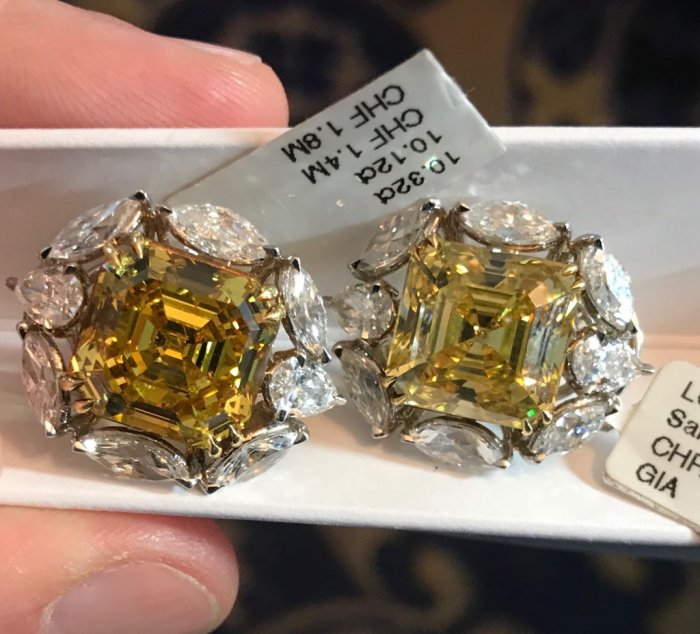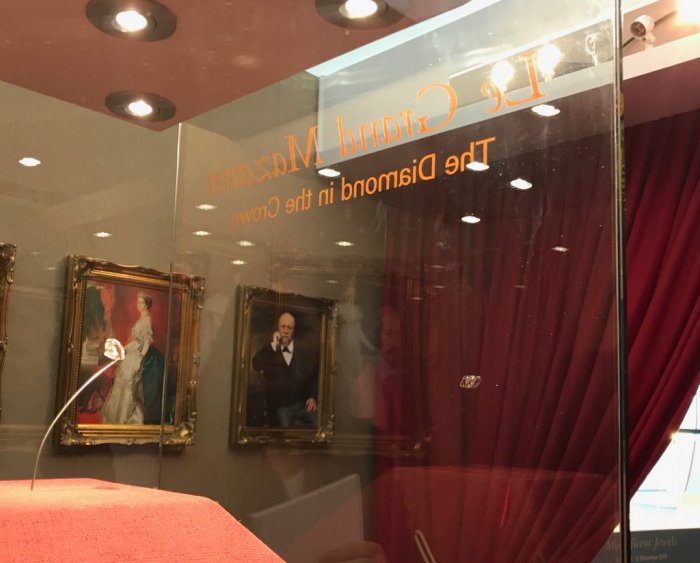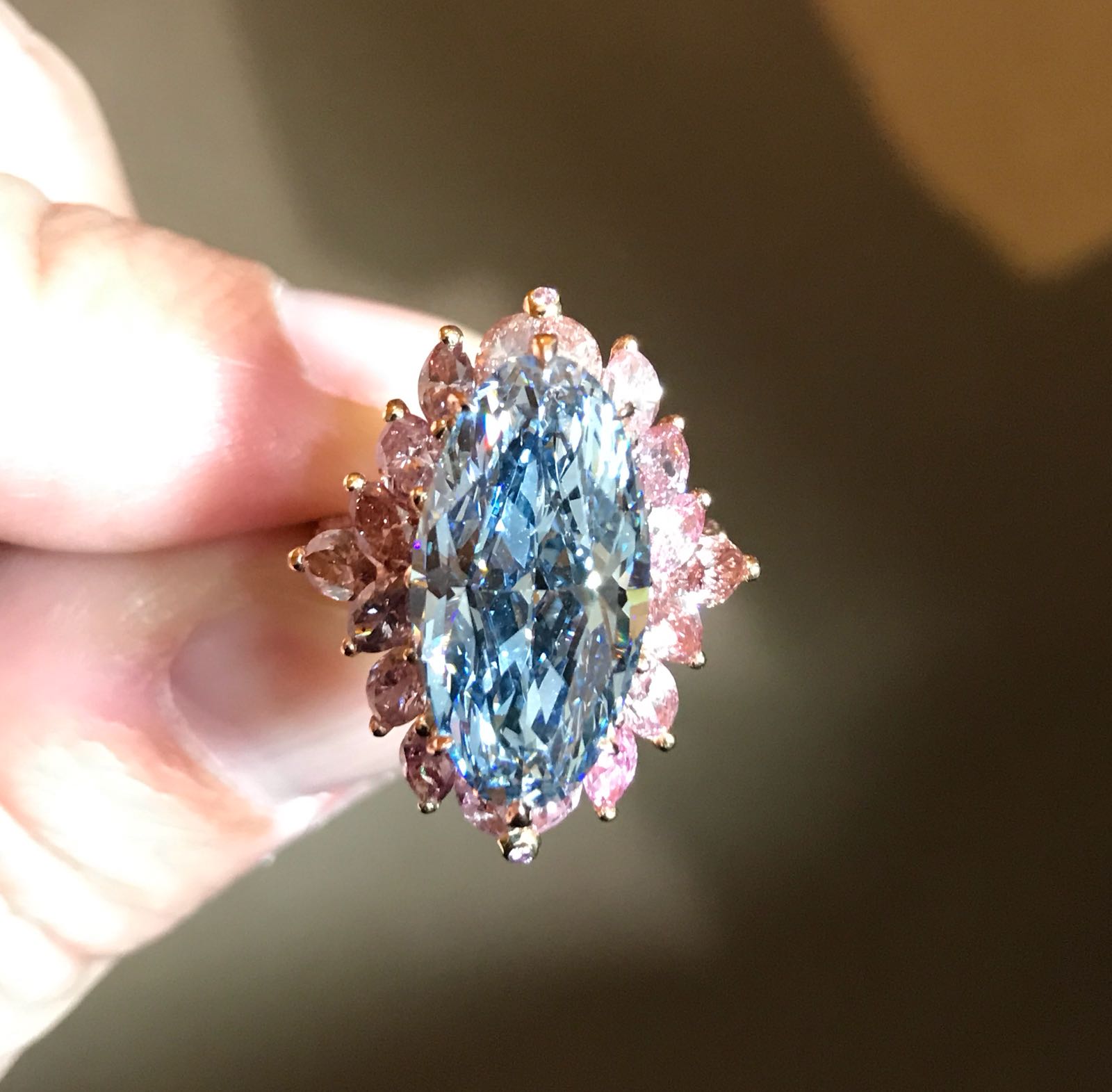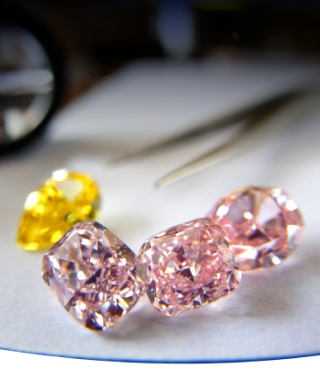Pre-Auction Analysis: Magnificent Jewels Christie’s Nov 14 and Sotheby’s Nov 15 Geneva 2017
This pre-auction analysis will focus on visual elements and other observations that are not expressed on the GIA report nor in the catalog. Our analysis expresses characteristics such as Undertone, Color Dispersion, and Inner-Grade (UDI). We use grades 1, 2, 3, and 4 (grade 1 is the lowest grade).
The grade 4+ is granted in rare cases and stands for an exceptional characteristic. Stones that receive a total UDI score of 8 or above (SI1 or better) are considered to be gems and are probably suitable for high-end jewelry, collectors, and the investment community.
For your convenience, we have added direct links for the GIA reports and for the FCRF Rarity reports.
All images in this article review were taken with an iPhone 7.
All auction valuations are per carat and in US Dollars.
Christie’s Magnificent Jewels 14 November 2017, Geneva
Lot #460
9.17 carat fancy intense pink pear, SI1
High estimation: $491,241 per carat
Price Realized: $569,721 per carat
A fancy intense pink old mine pear shape cut with a very noticeable black inclusion underneath the crown and a penetrating feather from the girdle inside (hidden under one of the gold prongs). The inner-grade is low and receives the grade 1, which means it’s borderline being a fancy pink.
The color dispersion is low and this is due to the fact it’s an old mine cut. It receives the grade 2.
The pink undertone is quite good with a minor orange presence and receives the grade 3.
Re-cutting the stone to a VS Clarity might take some significant weight loss in this case.
Total quality score: 6
To review the GIA Report Click here
To review the FCRF Rarity Report Click here
Lot #477
10.32 & 10.12 carats fancy vivid yellow square emeralds, SI2, SI1
High catalog estimation: $88,334 per carat
Not Sold
Finding a matching pair of vivid yellow in such large sizes is very rare, especially when it comes to step cut diamonds. However, the compatibility of these two stones is not very high.
There are significant differences in the vivid inner-grade, one receiving the grade 4 (very strong vivid) and the other the grade 2.
When it comes to the make, the faceting architecture is so different between them (the culet alignment would be an obvious example) that it would be safe to say that they were polished by two different owners. The fact that they found themselves together as a pair is quite coincidental.
The undertone of one leans toward the orange and receives the grade 4, while the other is average and receives the grade 3.
The color dispersion is quite good in both stones and each receives the grade 4.
Total quality score: 10

To review the GIA Reports Click here and here
To review the FCRF Rarity Report Click here and here
Lot #495
8.67 carat fancy intense blue rectangular, VVS1
High catalog estimation: $1,214,799 per carat
Price Realized: $1,537,156 per carat
Almost no new blue fancy color rough has come out of the ground in recent years, hence the vast majority of blue diamonds on the marketplace actually found their way back from veteran collectors or their families.
Although it’s a common phenomenon with any step cut diamond, this intense blue emerald (a modified step cut, according to the GIA) has a very low color dispersion, as the color is situated at the far edges of the stone, and receives the grade 1 (not as seen in the catalog).
The inner-grade is quite good and receives the grade 3.
The undertone is above average, with almost no presence of a gray undertone and receives the grade 3.
Total quality score: 7
To review the GIA Report Click here
To review the FCRF Rarity Report Click here
Lot #504
5.08 carat fancy pink oval brilliant, VS1
High catalog estimation: $296,184 per carat
Price Realized: $649,498 per carat
This pink oval was probably polished in the previous century. Modern pink diamonds are polished as modified cuts in order to lengthen the light wave in the stone and enhance saturation.
Because the stone is cut like a colorless diamond, the color dispersion is at its lowest and receives the grade 1.
The inner-grade is quite strong from a side view but quite low on the face-up view and receives the grade 2.
For a pink with no purple modifier the hue is quite good, with little orange influence, and receives the grade 3.
Total quality score: 6
To review the GIA Report Click here
To review the FCRF Rarity Report Click here
Lot #600 – The Grand Mazarin
19.07 carats light pink color, VS2 (type IIA classification letter)
Price Realized: $764,683 per carat
Out of all Type IIa pink diamonds seen in recent years on the marketplace, with this diamond, due to its pedigree, it is possible to say with a very high certainty that it comes from the Golconda region in India. Diamonds from this region hold a valuable romantic load, but this fact alone doesn’t really indicate quality, as most Type IIa pink diamonds do not hold the high transparency quality colorless stones have.
*To read the FCRF article “Not My ‘Type’: Common Misconceptions About Type IIa Pink Diamonds”: Click here
According to the GIA report, the color distribution is not applicable, which means that the color is too weak to determine how well it is distributed around the stone because it blends with other reflections in the stone. In addition, the warm yellow light and the pink background in which it is displayed completely washes out any trace of the pink hue. (Both the light and background should have been white in order to see the pink color in the stone.)
Total quality score: Not applicable

To review the GIA Report Click here
To review the FCRF Rarity Report Click here
Sotheby’s Magnificent Jewels and Noble Jewels
Lot #361
37.30 carat fancy intense pink cushion modified brilliant, VS1
High catalog estimation: $806,751 per carat
According to the GIA, this is the largest fancy intense pink in the world. In most cases this fact by itself is a crucial factor in making a stone very desirable. However, the fact that the GIA report states that the stone has a strong blue fluorescence may be a significant hindrance. Having said that, in this particular case the negative effect of its strong blue fluorescence is not very visible.
The inner-grade is a bit weak and receives the grade 2.
The undertone has almost no orange effect and receives the grade 3.
Color dispersion is average, with some colorless patches on the crown, and receives the grade 3.
Total quality score: 8
To review the GIA Report Click here
To review the FCRF Rarity Report Click here
Lot #337
7.41 carat fancy vivid blue oval modified brilliant, VVS1
High catalog estimation: $2,436,861 per carat
From the elongated shape of the stone, it is possible to assume that this oval was a marquise shape in its first incarnation. The wider girdle on the two edges of the stone supports that assumption. The blue color on this stone is a bit elusive, and some professional have reported they see a strange secondary color in the diamond. The reason for that is that the pink gold setting and the pink diamonds surrounding the stone reflect inside the crystal. The fact the stone has many colorless windows helps this phenomenon as well.
The inner-grade is not very strong and receives the grade 2.
The undertone has no gray effect and receives the grade 4.
The color dispersion is low and receives the grade 2.
Total quality score: 8
To review the GIA Report Click here
To review the FCRF Rarity Report Click here
General
We use 1, 2, 3, 4, and 4+ to grade the three visual elements that GIA is silent about, that, however, impact value dramatically.
Inner-Grade refers to the strength of color within each GIA saturation category:
- Grade 1 weakest, bordering the saturation below.
- Grade 2 weak (most abounded).
- Grade 3 full-bodied color (above average).
- Grade 4 very strong saturation.
- Grade 4+ applies for the vivid category only, exhibiting the strongest possible saturation (rarely seen).
Undertone refers to a subtle hue influence in the body color of the stone. For example:
A fancy blue diamond with a significant gray presence in its general appearance will be graded with a low undertone grade of 1. A fancy blue that has no gray influence and will be close to a primary blue will receive the grade 4.
In a pink fancy color diamond, a stone with a warm undertone (such as orange or brown) will receive a low undertone grade. A pink stone with a cold undertone (such as purple) will receive a high grade.
In yellow fancy color diamonds, low foreign influence or a light orange influence will grant the stone a high undertone grade. When the yellow undertone looks like a true primary yellow, it will receive the rare grade 4+. Green and brown undertones will grant a low grade in the yellow category.
Color Dispersion relates to how well the color is dispersed in the face-up view of a fancy color diamond, regardless whether the GIA grades the stone as even. A stone with many colorless areas will receive the grade 1, while a stone that exhibits its face-up view with no colorless patches will receive the grade 4+. Unlike the first two elements, color dispersion is not a gemological quality and has only to do with cutter proficiency.


